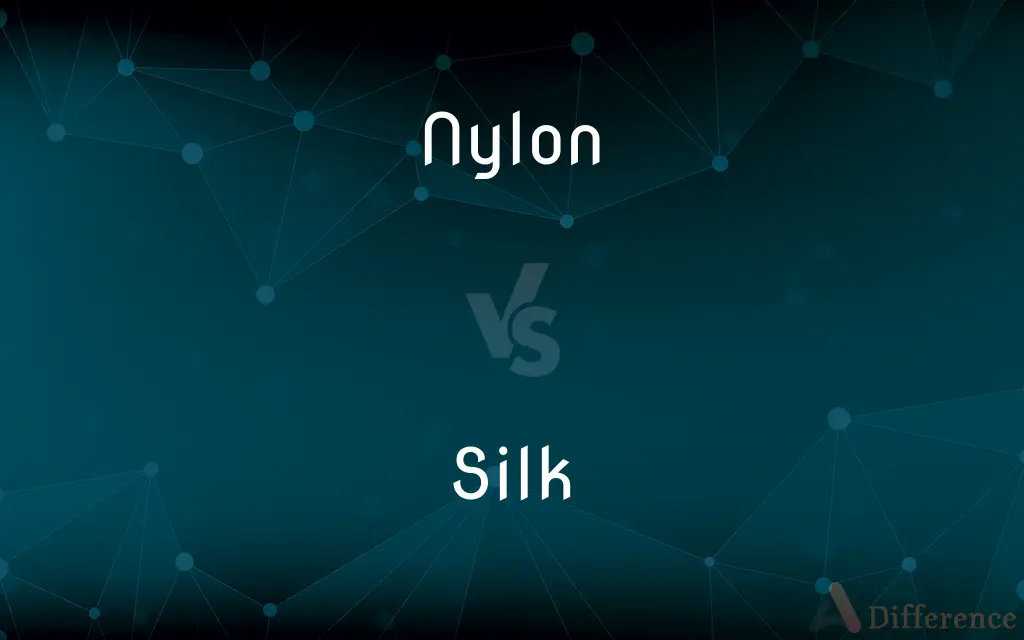Nylon vs. Silk — What's the Difference?
By Tayyaba Rehman — Updated on November 4, 2023
Nylon is a synthetic polymer, durable and elastic, while silk is a natural protein fiber known for its sheen and luxurious feel.

Difference Between Nylon and Silk
Table of Contents
ADVERTISEMENT
Key Differences
Nylon is a synthetic material, known for its strength and elasticity, making it a favorite for various textiles and industrial applications. Silk, in contrast, is a natural fiber produced by silkworms, valued for its softness and natural sheen, and is often used in high-end fashion garments.
Nylon, being synthetic, is typically more affordable and offers high durability which lends itself to a wide range of uses from clothing to car parts. Silk's natural origins contribute to its higher cost and it is not as widely used in industrial contexts but is renowned in the textile industry for luxury items.
The production of nylon is a chemical process involving the polymerization of certain petrochemicals, which makes it less environmentally friendly compared to silk, which is a renewable resource, though the farming of silkworms raises its own ethical and environmental concerns.
While nylon can be machine washed and is resistant to many chemicals, silk requires more delicate handling, often necessitating hand washing or dry cleaning due to its protein-based structure which can be easily damaged by heat and chemicals.
Nylon fabrics can wick moisture away from the body, making them suitable for activewear, whereas silk absorbs moisture, which can make it less comfortable for intense activities but excellent for temperature regulation in fashion garments.
ADVERTISEMENT
Comparison Chart
Origin
Synthetic, man-made
Natural, produced by silkworms
Durability
Highly durable, strong
Less durable, can degrade with sun exposure
Texture
Typically smooth, can vary
Naturally smooth, soft with a unique sheen
Care
Easy to care for, machine washable
Requires gentle care, often dry clean only
Environmental Impact
Petrol-based production, not biodegradable
Renewable, but sericulture has impacts
Compare with Definitions
Nylon
Versatile Polymer
The nylon stockings were remarkably resilient.
Silk
Natural Fiber
The wedding dress was crafted from pure silk.
Nylon
Water-Resistant
Her nylon jacket repelled the rain effectively.
Silk
Protein Filament
Silk curtains added an elegant touch to the room.
Nylon
Elastic Fabric
The nylon in these leggings allows for great flexibility.
Silk
High-Sheen Material
Silk ties are known for their glossy finish.
Nylon
Nylon is a generic designation for a family of synthetic polymers composed of polyamides (repeating units linked by amide links). Nylon is a silk-like thermoplastic, generally made from petroleum, that can be melt-processed into fibers, films, or shapes.
Silk
Luxurious Texture
He gifted her a scarf made of the finest silk.
Nylon
Any of a family of high-strength, resilient synthetic polymers, the molecules of which contain the recurring amide group CONH.
Silk
Silk is a natural protein fiber, some forms of which can be woven into textiles. The protein fiber of silk is composed mainly of fibroin and is produced by certain insect larvae to form cocoons.
Nylon
Cloth or yarn made from one of these synthetic materials.
Silk
A fine lustrous fiber composed mainly of fibroin and produced by certain insect larvae to form cocoons, especially the strong, elastic, fibrous secretion of silkworms used to make thread and fabric.
Nylon
Nylons Stockings made of one of these synthetic materials.
Silk
Thread or fabric made from this fiber.
Nylon
Originally, the DuPont company trade name for polyamide, a copolymer whose molecules consist of alternating diamine and dicarboxylic acid monomers bonded together; now generically used for this type of polymer.
Silk
A garment made from this fabric.
Nylon
(in the plural) A stocking originally fabricated from nylon; also used generically for any long, sheer stocking worn on a woman's legs.
I tore a hole in my nylons while walking home through the woods.
Silk
A silky filamentous material spun by a spider or an insect such as a webspinner.
Nylon
(perjoratively, by comparison to silk) A Queen's Counsel, King's Counsel or Senior Counsel who was appointed as a courtesy, rather than on merit.
Silk
A silky filamentous material produced by a plant, such as the styles forming a tuft on an ear of corn.
Nylon
Any of several thermoplastic polyamide plastics, comprising a family of high-strength resilient synthetic materials, used mostly in fibers.
Silk
Silks The brightly colored identifying garments of a jockey or harness driver.
Nylon
A synthetic fabric consisting of fibers of nylon[wn1].
Silk
Composed of or similar to the fiber or the fabric silk.
Nylon
Stockings made of a thin form of nylon{2}, especially full-length stockings either sheer of of varying shades.
Silk
To develop silk. Used of corn.
Nylon
A thermoplastic polyamide; a family of high-strength resilient synthetic materials
Silk
A fine fiber excreted by the silkworm or other arthropod (such as a spider).
The thread made of silk was barely visible.
Nylon
A synthetic fabric
Silk
A fine, soft cloth woven from silk fibers.
Nylon
Synthetic Fiber
The camping gear is made from high-strength nylon.
Silk
Anything which resembles silk, such as the filiform styles of the female flower of maize, or the seed covering of bombaxes.
Nylon
Durable Material
They used nylon ropes for the climbing expedition.
Silk
The gown worn by a Senior (i.e. Queen's/King's) Counsel.
Silk
(colloquial) A Queen's Counsel, King's Counsel or Senior Counsel.
Silk
A pair of long silk sheets suspended in the air on which a performer performs tricks.
Silk
The garments worn by a jockey displaying the colors of the horse's owner.
Silk
(transitive) To remove the silk from (corn).
Silk
The fine, soft thread produced by various species of caterpillars in forming the cocoons within which the worm is inclosed during the pupa state, especially that produced by the larvæ of Bombyx mori.
Silk
Hence, thread spun, or cloth woven, from the above-named material.
Silk
That which resembles silk, as the filiform styles of the female flower of maize.
Silk
A fabric made from the fine threads produced by certain insect larvae
Silk
Fibers from silkworm cocoons provide threads for knitting
Silk
Thermoregulator
The silk blouse was comfortable even in the summer heat.
Common Curiosities
Why is silk considered luxurious?
Silk is considered luxurious due to its natural sheen, softness, and relative rarity.
How is silk produced?
Silk is produced by silkworms, which spin their cocoons from silk fibroin.
Are nylon products recyclable?
Some nylon products are recyclable, but recycling facilities vary by location.
Is nylon more sustainable than silk?
Not typically; nylon is petroleum-based, while silk is a natural, renewable resource.
Can silk be vegan?
Traditional silk is not vegan as it involves silkworms, but synthetic alternatives exist.
Is silk hypoallergenic?
Silk is often considered hypoallergenic and is less likely to cause allergic reactions.
What are the care instructions for nylon?
Nylon can usually be machine washed and is resistant to stains and wrinkles.
Is nylon biodegradable?
Nylon is not biodegradable and can take 30-40 years to decompose.
What is nylon most commonly used for?
Nylon is commonly used for textiles, activewear, ropes, and industrial materials.
How is silk harvested?
Silk is harvested by boiling the silkworm cocoons to extract the silk threads.
Does nylon have any natural origins?
No, nylon is completely synthetic, made from petrochemicals.
Can silk garments be machine washed?
Usually not; most silk garments require hand washing or dry cleaning.
Are there waterproof nylon products?
Yes, many nylon products are treated to be waterproof or water-resistant.
Does silk have any health benefits?
Silk is breathable and can have skin and hair benefits due to its smoothness.
How does the cost of nylon compare to silk?
Nylon is generally less expensive than silk, which is a premium material.
Share Your Discovery

Previous Comparison
Allegation vs. Accusation
Next Comparison
Hart vs. HeartAuthor Spotlight
Written by
Tayyaba RehmanTayyaba Rehman is a distinguished writer, currently serving as a primary contributor to askdifference.com. As a researcher in semantics and etymology, Tayyaba's passion for the complexity of languages and their distinctions has found a perfect home on the platform. Tayyaba delves into the intricacies of language, distinguishing between commonly confused words and phrases, thereby providing clarity for readers worldwide.















































